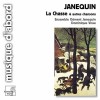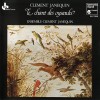Composers
Clément Janequin (c. 1485 – 1558) was a French composer of the Renaissance. He was one of the most famous composers of popular chansons of the entire Renaissance, and along with Claudin de Sermisy, was hugely influential in the development of the Parisian chanson, especially the programmatic type. The wide spread of his fame was made possible by the concurrent development of music printing.
Janequin was born in Châtellerault, Vienne, near Poitiers, though no documents survive which establish any details of his early life or training. His career was highly unusual for his time, in that he never had a regular position with a cathedral or an aristocratic court. Instead he held a series of minor positions, often with important patronage. In 1505 he was employed as a clerk in Bordeaux, to Lancelot du Fau, who eventually became Bishop of Luçon; he retained this position until du Fau's death in 1523, at which time he took a position with the Bishop of Bordeaux. Around this time he became a priest, though his appointments were rarely lucrative; indeed he always complained about money.
After 1530 Janequin held a succession of posts in Anjou, beginning as a singing teacher to the choirboys at the cathedral at Auch, and progressing to maître de chapelle at the singing school at Angers Cathedral. Around this time he attracted the attention of Jean de Guise, the patron of Erasmus, Clément Marot, and Rabelais; it was a welcome career boost, and, in 1548, with the additional assistance of Charles de Ronsard (the brother of poet Pierre de Ronsard), he became curate at Unverre, not far from Chartres. During this time he lived in Paris. By 1555 he was listed as a "singer ordinary" of the king's chapel, and shortly thereafter became "composer ordinary" to the king: only one composer (Sandrin, also known as Pierre Regnault) had previously had this title. In his will, dated January 1558, he left a small estate to charity, and he complained again of age and poverty in a dedication to a work published posthumously in 1559. He died in Paris.
Few composers of the Renaissance were more popular in their lifetimes than Janequin. His chansons were well-loved and widely sung. The Paris printer Pierre Attaingnant printed five volumes with his chansons. La bataille, which vividly depicts the sounds and activity of a battle, is a perennial favorite of a cappella singing groups even in the present day.
Janequin wrote very little liturgical music: only two masses and a single motet are attributed to him, though more may have been lost. His 250 secular chansons and his (over 80) psalm settings and chansons spirituelles — the French equivalent of the Italian madrigale spirituale — were his primary legacy.
The programmatic chansons for which Janequin is famous were long, sectional pieces, and usually cleverly imitated natural or man-made sounds. Le chant des oiseaux imitates bird-calls; La chasse the sounds of a hunt; and La bataille (Escoutez tous gentilz), probably the most famous, and almost certainly written to celebrate the French victory over the Swiss Confederates at the Battle of Marignano in 1515, imitates battle noises, including trumpet calls, cannon fire and the cries of the wounded Onomatopoeic effects such as these became a commonplace in later 16th century music, and carried over into the Baroque era; indeed "battle music" was to become a cliché, but it first came into prominence with Janequin.
In addition to the programmatic chansons for which he is most famous, he also wrote short and refined compositions more in the style of Claudin de Sermisy. For these he set texts by some of the prominent poets of the time, including Clément Marot. Late in his life he wrote the Psalm settings based on Genevan tunes. Since there is no documentary evidence, the question of whether he sympathized with the Protestants remains unanswered.
Recently Added
| Country: | France |
| Period: | Renaissance |
Biography
Clément Janequin (c. 1485 – 1558) was a French composer of the Renaissance. He was one of the most famous composers of popular chansons of the entire Renaissance, and along with Claudin de Sermisy, was hugely influential in the development of the Parisian chanson, especially the programmatic type. The wide spread of his fame was made possible by the concurrent development of music printing.
Janequin was born in Châtellerault, Vienne, near Poitiers, though no documents survive which establish any details of his early life or training. His career was highly unusual for his time, in that he never had a regular position with a cathedral or an aristocratic court. Instead he held a series of minor positions, often with important patronage. In 1505 he was employed as a clerk in Bordeaux, to Lancelot du Fau, who eventually became Bishop of Luçon; he retained this position until du Fau's death in 1523, at which time he took a position with the Bishop of Bordeaux. Around this time he became a priest, though his appointments were rarely lucrative; indeed he always complained about money.
After 1530 Janequin held a succession of posts in Anjou, beginning as a singing teacher to the choirboys at the cathedral at Auch, and progressing to maître de chapelle at the singing school at Angers Cathedral. Around this time he attracted the attention of Jean de Guise, the patron of Erasmus, Clément Marot, and Rabelais; it was a welcome career boost, and, in 1548, with the additional assistance of Charles de Ronsard (the brother of poet Pierre de Ronsard), he became curate at Unverre, not far from Chartres. During this time he lived in Paris. By 1555 he was listed as a "singer ordinary" of the king's chapel, and shortly thereafter became "composer ordinary" to the king: only one composer (Sandrin, also known as Pierre Regnault) had previously had this title. In his will, dated January 1558, he left a small estate to charity, and he complained again of age and poverty in a dedication to a work published posthumously in 1559. He died in Paris.
Few composers of the Renaissance were more popular in their lifetimes than Janequin. His chansons were well-loved and widely sung. The Paris printer Pierre Attaingnant printed five volumes with his chansons. La bataille, which vividly depicts the sounds and activity of a battle, is a perennial favorite of a cappella singing groups even in the present day.
Janequin wrote very little liturgical music: only two masses and a single motet are attributed to him, though more may have been lost. His 250 secular chansons and his (over 80) psalm settings and chansons spirituelles — the French equivalent of the Italian madrigale spirituale — were his primary legacy.
The programmatic chansons for which Janequin is famous were long, sectional pieces, and usually cleverly imitated natural or man-made sounds. Le chant des oiseaux imitates bird-calls; La chasse the sounds of a hunt; and La bataille (Escoutez tous gentilz), probably the most famous, and almost certainly written to celebrate the French victory over the Swiss Confederates at the Battle of Marignano in 1515, imitates battle noises, including trumpet calls, cannon fire and the cries of the wounded Onomatopoeic effects such as these became a commonplace in later 16th century music, and carried over into the Baroque era; indeed "battle music" was to become a cliché, but it first came into prominence with Janequin.
In addition to the programmatic chansons for which he is most famous, he also wrote short and refined compositions more in the style of Claudin de Sermisy. For these he set texts by some of the prominent poets of the time, including Clément Marot. Late in his life he wrote the Psalm settings based on Genevan tunes. Since there is no documentary evidence, the question of whether he sympathized with the Protestants remains unanswered.




